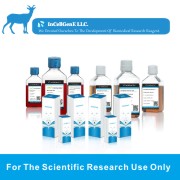

Overview
| Organism | Homo sapiens, human |
|---|---|
| Tissue | mammary gland /breast |
| Cell Type | epithelial |
| Product Format | frozen |
| Morphology | epithelial |
| Culture Properties | adherent |
| Biosafety Level |
1
Biosafety classification is based on U.S. Public Health Service Guidelines, it is the responsibility of the customer to ensure that their facilities comply with biosafety regulations for their own country. |
| Age | 48 years adult |
| Gender | female |
| Ethnicity | Caucasian |
| Applications | The cell line is an in vitro tool for research in endocrine activity of the human androgen receptor and glucocorticoid receptor. It can be used to screen chemicals for both androgen receptor and glucocorticoid receptor mediated activities. |
| Storage Conditions | liquid nitrogen vapor phase |
Properties
| Derivation | The MDA-kb2 cell line was derived from the breast cancer cell line, MDA-MB-453 (see ATCC HTB-131) by stable transfection with a mouse mammary tumor virus (MMTV) luciferase-neo reporter gene construct. |
|---|---|
| Clinical Data |
48 years adult
Caucasian
female
|
| Receptor Expression |
androgen receptor
glucocorticoid receptor, positive
|
| Genes Expressed |
luciferase. Ref The cell line expresses firefly luciferase under control of the MMTV promoter that contains response elements for both glucocorticoid receptors (GR) and androgen receptors (AR). |
| Cellular Products |
luciferase
Ref(The cell line expresses firefly luciferase under control of the MMTV promoter that contains response elements for both glucocorticoid receptors (GR) and androgen receptors (AR).)
|
| Comments |
Since both glucocorticoid receptor and androgen receptor are present in the MDA-MB-453 cells, and both receptors can act through the MMTV promoter, compounds that act through either androgen receptor or glucocorticoid receptor activate the MMTV luciferase reporter. Androgen receptor agonists such as dihydrotestosterone, and glucocorticoid receptor agonists such as dexamethasone, corticosterone, and aldosterone induce luciferase expression. Responsiveness of the cell line was monitored over time and was stable for more than 80 passages.
|
Background
| Complete Growth Medium |
The base medium for this cell line is ATCC-formulated Leibovitz''s L-15 Medium, Catalog No. 30-2008. To make the complete growth medium, add the following components to the base medium: fetal bovine serum to a final concentration of 10%.
(Note: The L-15 medium formulation was devised for use in a free gas exchange with atmospheric air. A CO2 and air mixture is detrimental to cells when using this medium for cultivation) |
|---|---|
| Subculturing |
Volumes used in this protocol are for 75 cm2 flask; proportionally reduce or increase amount of dissociation medium for culture vessels of other sizes.
Subculture Ratio: 1:2 to 1:4
Medium Renewal: Every 2 to 3 days.
Note: For more information on enzymatic dissociation and subculturing of cell lines consult Chapter 10 in Culture of Animal Cells, a manual of Basic Technique by R. Ian Freshney, 3rd edition, published by Alan R. Liss, N.Y., 1994.
|
| Cryopreservation |
Freeze medium: Complete growth medium supplemented with 5% (v/v) DMSO
Storage temperature: liquid nitrogen vapor phase
|
| Culture Conditions |
Atmosphere: air, 100%
Temperature: 37��C
|


